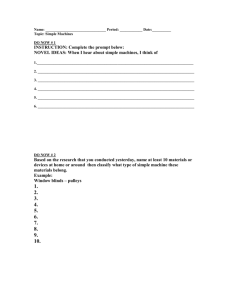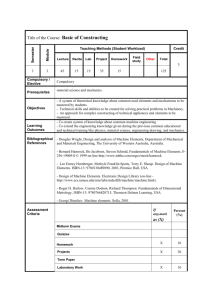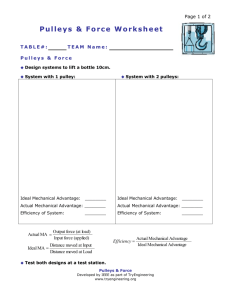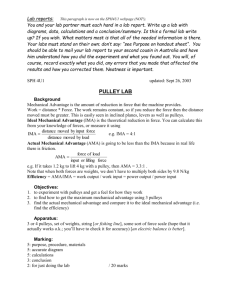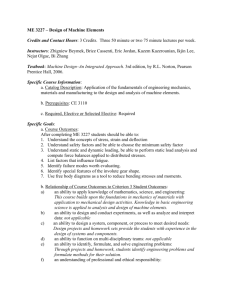gr4_strucutresmechanisms
advertisement
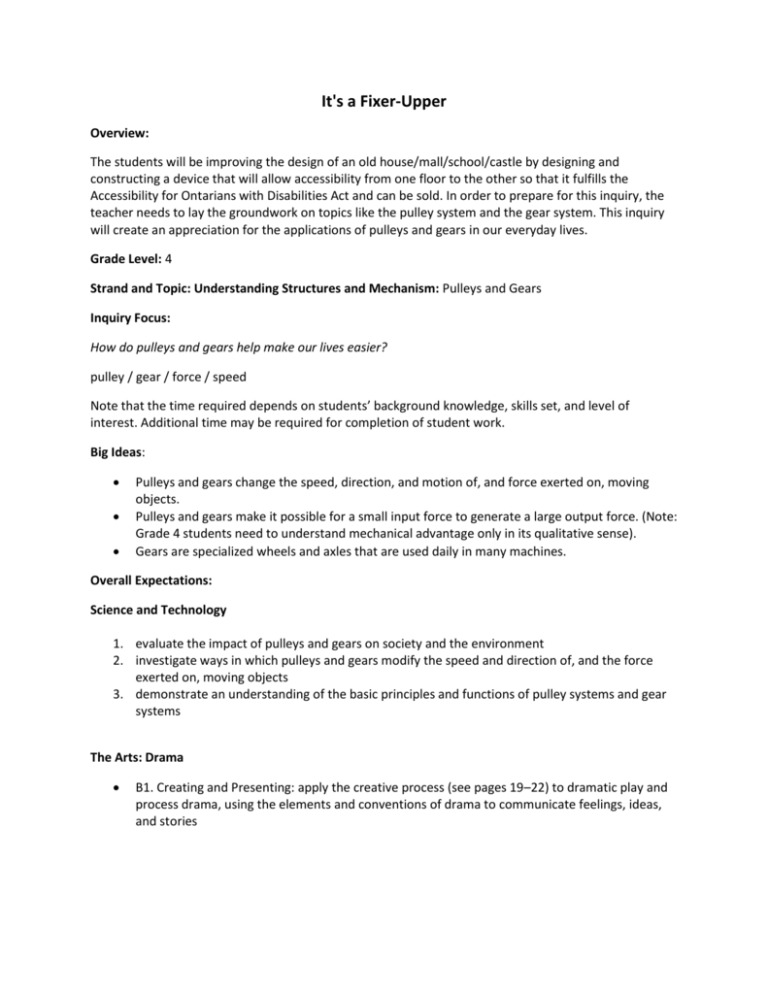
It's a Fixer-Upper Overview: The students will be improving the design of an old house/mall/school/castle by designing and constructing a device that will allow accessibility from one floor to the other so that it fulfills the Accessibility for Ontarians with Disabilities Act and can be sold. In order to prepare for this inquiry, the teacher needs to lay the groundwork on topics like the pulley system and the gear system. This inquiry will create an appreciation for the applications of pulleys and gears in our everyday lives. Grade Level: 4 Strand and Topic: Understanding Structures and Mechanism: Pulleys and Gears Inquiry Focus: How do pulleys and gears help make our lives easier? pulley / gear / force / speed Note that the time required depends on students’ background knowledge, skills set, and level of interest. Additional time may be required for completion of student work. Big Ideas: Pulleys and gears change the speed, direction, and motion of, and force exerted on, moving objects. Pulleys and gears make it possible for a small input force to generate a large output force. (Note: Grade 4 students need to understand mechanical advantage only in its qualitative sense). Gears are specialized wheels and axles that are used daily in many machines. Overall Expectations: Science and Technology 1. evaluate the impact of pulleys and gears on society and the environment 2. investigate ways in which pulleys and gears modify the speed and direction of, and the force exerted on, moving objects 3. demonstrate an understanding of the basic principles and functions of pulley systems and gear systems The Arts: Drama B1. Creating and Presenting: apply the creative process (see pages 19–22) to dramatic play and process drama, using the elements and conventions of drama to communicate feelings, ideas, and stories Social Studies: A. Heritage and Identity: Early Societies, 3000 BCE–1500 CE A3. Understanding Context: demonstrate an understanding of key aspects of a few early societies (3000 BCE–1500 CE), each from a different region and era and representing a different culture, with reference to their political and social organization, daily life, and relationships with the environment and with each other Mathematics: Measurement - estimate, measure, and record length, perimeter, area, mass, capacity, volume, and elapsed time, using a variety of strategies Mathematics: Geometry and Spatial Sense - construct three-dimensional figures, using two-dimensional shapes Language: Oral Communication 1. listen in order to understand and respond appropriately in a variety of situations for a variety of purposes 2. use speaking skills and strategies appropriately to communicate with different audiences for a variety of purposes Language: Reading 1. read and demonstrate an understanding of a variety of literary, graphic, and informational texts, using a range of strategies to construct meaning Language: Writing 1. generate, gather, and organize ideas and information to write for an intended purpose and audience Language: Media Literacy 3. create a variety of media texts for different purposes and audiences, using appropriate forms, conventions, and techniques Specific Expectations: Science and Technology 1.2 assess the environmental impact of using machines with pulleys and gears, taking different perspectives into account (e.g., the perspectives of a car driver or cyclist, someone who is physically challenged, the owner of a multifloor building), and suggest ways to minimize negative impacts and maximize positive impacts 2.1 follow established safety procedures for working with machinery 2.2 use scientific inquiry/experimentation skills (see page 12) to investigate changes in force, distance, speed, and direction in pulley and gear systems 2.3 use technological problem-solving skills (see page 16) to design, build, and test a pulley or gear system that performs a specific task 2.4 use appropriate science and technology vocabulary, including pulley, gear, force, and speed, in oral and written communication 3.1 describe the purposes of pulley systems and gear systems 3.3 describe how one type of motion can be transformed into another type of motion using pulleys or gears 3.5 distinguish between pulley systems and gear systems that increase force and those that increase speed 3.6 identify pulley systems (e.g., clotheslines, flagpoles, cranes, elevators, farm machinery) and gear systems (e.g., bicycles, hand drills, can openers) that are used in daily life, and explain the purpose and basic operation of each 3.7 explain how the gear system on a bicycle works 3.8 identify the input components that drive a mechanism and the output components that are driven by it The Arts: Drama B1.4 communicate thoughts, feelings, and ideas to a specific audience, using audio, visual, and/or technological aids to enhance their drama work Social Studies: A. Heritage and Identity: Early Societies, 3000 BCE–1500 CE A3.2 demonstrate the ability to extract information on daily life in early societies from visual evidence Mathematics: Measurement - estimate, measure, and record the mass of objects (e.g., apple, baseball, book), using the standard units of the kilogram and the gram estimate, measure, and record length, height, and distance, using standard units (i.e., millimetre, centimetre, metre, kilometre) describe, through investigation, the relationship between various units of length (i.e., millimetre, centimetre, decimetre, metre, kilometre) determine, through investigation, the relationship between grams and kilograms determine, through investigation, the relationship between millilitres and litres Mathematics: Geometry and Spatial Sense - construct a three-dimensional figure from a picture or model of the figure, using connecting cubes (e.g., use connecting cubes to construct a rectangular prism) Language: Oral Communication 1.2 demonstrate an understanding of appropriate listening behaviour by adapting active listening strategies to suit a variety of situations, including work in groups 1.6 extend understanding of oral texts by connecting the ideas in them to their own knowledge, experience, and insights; to other texts, including print and visual texts; and to the world around them 2.2 demonstrate an understanding of appropriate speaking behaviour in a variety of situations, including paired sharing and small- and large-group discussions 2.3 communicate in a clear, coherent manner, presenting ideas, opinions, and information in a readily understandable form 2.6 identify some non-verbal cues, including facial expression, gestures, and eye contact, and use them in oral communications, appropriately and with sensitivity towards cultural differences, to help convey their meaning 2.7 use a variety of appropriate visual aids (e.g., CDs or DVDs, computer-generated graphic organizers, concrete materials, artefacts) to support or enhance oral presentations Language: Reading 1.4 demonstrate understanding of a variety of texts by summarizing important ideas and citing supporting details 1.6 extend understanding of texts by connecting the ideas in them to their own knowledge, experience, and insights, to other familiar texts, and to the world around them Language: Writing 1.2 generate ideas about a potential topic using a variety of strategies and resources 1.3 gather information to support ideas for writing using a variety of strategies and oral, print, and electronic sources Language: Media Literacy 3.1 describe in detail the topic, purpose, and audience for media texts they plan to create 3.4 produce media texts for specific purposes and audiences, using a few simple media forms and appropriate conventions and techniques Key Concepts: Pulleys and gears can transfer motion from one object to another, transform one kind of motion into another, change the speed and direction of an object’s motion, and change the amount of force needed to move an object. Prior Skill Sets: The students should be familiar with the skills for investigating and researching from the previous grades and/or units. Similarly, the students should be familiar with the safety procedures for handling tools and materials, as well as have some knowledge of designing, building and testing devices. Prior Knowledge: Grade 2: Movement (Structures and Mechanisms) 3.3 identify the six basic types of simple machines – lever; inclined plane; pulley; wheel and axle, including gear; screw; and wedge – and give examples of ways in which each is used in daily life to make tasks easier 3.4 describe how each type of simple machine allows humans to move objects with less force than otherwise would be needed 3.5 identify simple machines used in devices that move people Grade 3: Forces Causing Movement (Matter and Energy) 3.1 identify a force as a push or a pull that causes an object to move 3.3 describe how different forces (e.g., magnetism, muscular force, gravitational force, friction) applied to an object at rest can cause the object to start, stop, attract, repel, or change direction 3.4 explain how forces are exerted through direct contact (e.g., pushing a door, pulling a toy) or through interaction at a distance Grade 3: Mathematics (Measurement) - estimate, measure, and record length, height, and distance, using standard units (i.e., centimetre, metre, kilometre) estimate, measure, and record the mass of objects (e.g., can of apple juice, bag of oranges, bag of sand), using the standard unit of the kilogram or parts of a kilogram estimate, measure, and record the capacity of containers (e.g., juice can, milk bag), using the standard unit of the litre or parts of a litre Materials and Equipment: word list of objects that use simple machines for charades (ex: can opener, stairs, etc) camera pencil and paper pictures contraptions that use pulleys and gears (and what it previously would have been in the past ex: horse vs bicycle) computer projector/SMART board internet access push pin/thumb tack for bulletin board post-its timer or online stopwatch (www.online-stopwatch.com/) dowels gears (or if resources are lacking, basswood/jinx wood/polyboards, rulers, mitre boxes, handdrills, glue, scissors) rulers string pulleys (or DIY pulleys using bottle caps/plywood and sandpaper), glue, pictures of old fixerupper buildings, LEGO/shoe boxes (or other kinds of boxes) Safety: A hands-on approach is important in the teaching and learning of science. Therefore, possible risks may not be entirely eliminated, but procedures and techniques may be modified to create a safe learning environment. The teacher must ensure that students understand potential dangers (tell them each safety consideration and ask them why it is important to observe them). Safety Considerations: - Instruct students not to use tools or materials for their unintended purpose, and not to use them without teacher approval - Check to ensure that pulley systems are firmly attached to a secure support before operating them - Refer to STAO Elementary Safety Resource (http://stao.ca/res2/unifElemSafety/ for Safety Considerations in Investigating Materials and Simple Machines (pg. 60-68), as well as Designing, Building and Constructing (pg. 72-80) Instructional Planning and Delivery: The instructional delivery of this inquiry moves from the teacher-directed Guided inquiry to Coupled inquiry. If there is more time, then an Open inquiry is possible as an Extension/Application. Ongoing assessment is important. If each day is not feasible, at least have students write a journal entry after each activity as part of Assessment as learning. The inquiry process is: Engage -> Explore -> Explain -> Extend -> Evaluate Type Structured or Directed Guided Coupled Open or Full Participant Teacher Initiated and Performed Teacher Initiated, Students Performed Teacher Initiated Student Initiated Teacher Directed Student Directed Path to Inquiry Engage (I SEE): Activate students’ prior knowledge and interest in the subject The students’ background knowledge and prior experience with simple machines will play a large role in their comfort level with the topic. The activity in Engage is used as a springboard into the the inquiry. To stimulate the thinking of students (I WONDER), there is also a stage for Questioning: Brainstorming on the topic. Have a Question matrix (https://belmontteach.files.wordpress.com/2014/01/questionmatrix.jpg) somewhere visible to the students (Language Arts board if your classroom has one) as a reference when they are trying to formulate their own questions. Be aware that the students will have questions during discussions, as well as questions that will come up when students are doing an activity. NOTE: If links do not work, copy and paste the link in a new tab/window. Activity 1: Introduction to Topic - Tools: post-it notes, word list of objects that use simple machines for charades (ex: can opener, stairs, etc.), camera/pencil and paper, pictures contraptions that use pulleys and gears (and what it previously would have been in the past ex: horse vs bicycle), computer, projector/SMART board, internet access, push pin/thumb tack for bulletin board Hook: Have the students play charades. Students are divided into groups and guess the items (the category would be that students are acting out objects that use gears and pulleys) With the whole class, the teacher then asks the students what category they think the charades were (gears and pulleys). The teacher then points out obvious pulley and gear systems in the classroom (the curtains if it uses pulleys or a flagpole, and to have a reason to bring a can opener, bring a canned good to open; If there is an elevator, the teacher can start the introduction there) - What simple machine is used? What is the object’s purpose? How does the simple machine help the object fulfill that purpose? Based on the object’s purpose, how are pulleys and gears different? What forces are present in the situation? How do those forces help/finder the purpose of the object? Social Studies connection: Teacher then prints pictures of past and present pulley/gear systems (horse vs bicycle, ladder vs elevator, hand drill vs hammer, can opener vs knife) and posts them around the room in a gallery walk. Students walk around writing comments and questions on post it notes and posting them beside the corresponding picture. When sufficient time has passed, bring the class back together, and put students into groups where they will discuss Same-Different: what's the same and what's different between each picture. Then, the teacher can bring back the class and incorporate the Medicine Wheel as a graphic organizer. The Medicine Wheel teaches us about equality and respect for all people of the four colours and the four directions. The four directions of the Medicine Wheel remind us of many things, such as the need for balance in the world, and the balance we must strive for everyday within ourselves. For the Spiritual portion of the medicine wheel, the students will reflect on where simple machines came from, and how it affects our lives (http://www.spiritsd.ca/learningresources/FNM%20Resources/GR5%20Forces%20and%20Simple%20M achines%20%282%29.pdf) - A Wonder Bulletin board concept map will be used as a tool for students to visualize and keep track of their learning. One idea would be to divide the board in half, one side for pulleys, the other for gears. On each side there is a designated area for questions with space to be able to provide the information gained from the inquiry activities. (Here is an example of a wonder bulletin board, showing how knowledge was accumulated and expanded upon : http://4.bp.blogspot.com/-QVbIraldeI/Ut1mBMgBGRI/AAAAAAAAD6s/5RY4DuO8Nto/s1600/bulletin+board.jpg) - Variation: Instead of the teacher printing a word list/pictures, take the class on a walk around the school/community to try to find other applications of pulleys and gears. The teacher provides the students either with drawing tools or a method to take pictures, then show the pictures either through a projector or a gallery walk, and do the same process as the Social Studies connection above Questioning (I WONDER) Pulleys should be familiar to the students from Grade 2, but gears might not be familiar to them. Therefore, misconceptions can also become an experiential activity and should be noted for possible exploration later. Questioning can be done collectively with the whole class so that the teacher can keep track of the questions, answer questions that should be answered immediately for safety, and help the students classify which questions can be safely carried out as an inquiry. Knowledge from personal and cultural experiences may also come up. It is important that the right environment is established for questioning and that the teacher models Questioning in such a way that asks for deeper thinking. The following websites have good advice on how to get students to think deeper: https://belmontteach.wordpress.com/2014/01/23/betterquestioning-thinking-about-thinking/ http://sayersjohn.blogspot.co.uk/2013/01/questioning.html Below are possible questions that the inquiry activities will be answering. Have the questions in mind, and try to steer student comments/questions in that direction. This is similar to co-creating Learning Goals, Success Criteria and Rubrics with the students. Of course, this will not always happen in reality and other questions will come up that cannot be placed under these inquiry questions. Any remaining questions should be collated and investigated as an Extension (see related section) Teacher-led How do pulleys and gears help make our lives easier? Are there costs to using pulleys and gears to make our lives easier? Student-led How does the size of the gear affect its use? (What happens if we have two big gears instead of one small, one large? What if we switch the front gears to the back? Is the size of the gear important?) How does the number of pulleys affect its use? (What happens if we put more pulleys? What if we put less pulleys? Is the length of the rope important?) Explore / Inquiry activity: (I DO): Inquiry process The idea is to gradually release responsibility and the ideal situation would be to have an Open inquiry where the teacher presents a topic (not the inquiry question) as well as the materials and students will design their own experience. In order to build student skills and confidence, the teacher can demonstrate the process through scaffolding and Guided and Coupled inquiry. Examples will be provided by the teacher, then the students will have hands-on experiences through designing/constructing pulleys/gears, all of which should allow the students to become more skillful. Activity 2: Experiment: Gears - Tools: gears: dowels, gears (or if resources are lacking, basswood/jinx wood/polyboards, rulers, mitre boxes, hand-drills, glue, saw/scissors) Teacher either starts with a video on how gears on bicycles work (https://www.youtube.com/watch?v=oauDyIu_swM, this video has Closed Captioning) or demonstrates using an actual bicycle by bringing your own bike, or asking a cyclist/bike enthusiast to come in and demonstrate. Have written instructions (as well as explain out loud for oral learners) while demonstrating how a bike works Invitation to inquiry: Tell the students that in the Ontario Science Center, there is a Gear Turning Exhibit near the Kid Spark zone, that demonstrates the rotary motion of gears and relates it to time (rotations of small gears translating to seconds/minutes, and one has to do the corresponding number of rotations before the gears for hours/days/years complete one rotation as a result) - How does rotation of the seconds gear affect the minutes gear? What would happen if we change the size of the seconds/minutes gear? As a class, go back to the bulletin board and have the students Think-Pair-Share about the bicycle or the gear exhibit, and comments or questions they have about it. After sufficient time has passed, invite the students to share, or even write their questions themselves on the designated space on the bulletin board - Inquiry questions: How does the size of the gear affect the speed? (What happens if we have two big gears instead of one small, one large? What if we switch the front gears to the back? Is the size of the gear important?) Students have an opportunity to experiment on gears based on their chosen inquiry questions. Review the Safety Considerations in the Safety section before proceeding Aside from questions, students need materials and the experimental process (Guided inquiry: teacher provides advises the student on how to proceed, Open: students write their own procedure). - If resources are lacking, or to help students start their design process, they can use the following websites: For creating gear templates to be printed then placed on top of wood/plastic to be traced and cut: http://woodgears.ca/gear_cutting/template.html Computer Simulation software where the students can use different sizes and numbers of gears: https://sites.google.com/site/simgears/ - Example: Question: What happens if we have two big gears instead of one small, one large? Procedure: Have two gear contraptions, one with different sizes, and the other with the same size but using only the large gears. Turn the front wheel one full rotation and look at the back wheel. Record how many times the back wheel turned with one rotation. Discuss the results with the group. - Option: A student that needs a lot of support can fill out a graphic organizer, All My Relations. It is an important tool which shows how actions affect each other in a First Nations community. The students would write down the relationships (classroom, school, home, community) or processes that would be affected by each other in the gears (ex: Earth goes around the Sun, which provides energy to Plants, which provides clean Air, which is breathed in by Animals, which are eaten by People) http://learning.arpdc.ab.ca/pluginfile.php/26398/mod_resource/content/1/OWVW_Section23.pdf - Variation: Open Inquiry: Math connection: Students will construct something similar to the Science Centre’s gear display about rotary motion. Instead of showing time, the turning gears would show conversion for meters (centi, milli, kilo), grams (kilo), or liters (milli), etc. If the construction is too complicated, the students could cut out paper gears, number the teeth and make sure the gears make complete, correct turns. Students collect data from a number of trials, then discuss within their groups the results of their experiment. Afterward, students communicate what they learned by updating the information in the bulletin board. The students will also reflect on their medicine wheel on the process of construction (Action portion of medicine wheel) It is a good idea to provide direct instruction at the end. Gather the class around the bulletin board and point out the important concepts about gears and the process that allowed the students to learn about it. This solidifies the knowledge gained from the inquiry experience, ensuring that all students can benefit from the constructed knowledge that the wonder bulletin board contains. Activity 3: Design: Pulleys - Tools: pulleys: rulers, string, pulleys (if no pulleys are available, DIY pulleys are made of bottle caps/plywood and sandpaper stuck together), glue, scissors, pictures of old fixer-upper buildings, LEGO (if there are not enough resources, students can stack shoe boxes or similar boxes to create different floors) The teacher starts off with this 6-minute video (https://www.youtube.com/watch?v=hA1efcxlooc) which explains the Accessibility Act. The video has subtitles. After, ask the students about the symbols used in the video to indicate Accessibility. What accommodations have been made for people with disabilities? How would our lives be different without ramps, elevators or escalators? Invitation to Inquiry: Pose scenario: Post pictures of old buildings around the classroom. These are old house/mall/castle/school for sale and in order to sell them, buyers are looking to buy something that has easy access from one floor to the next, to fulfill the Accessibility to Ontarians with Disabilities Act. The task for the students will be to build the contraptions that will allow easy access from each floor using the materials available. The students need to construct the building themselves (choose one of the pictures and construct it from lego). The students then have to design a contraption to complement their chosen building and then build it using the materials available. The teacher might set a minimum load of 2.5 kg that the contraption must be able to lift and assign heights (example: there are three floors and each floor is 10 cm from each other). The groups will then create a narrative to go with their building and contraption Students will then watch this Bill Nye video to remind them of pulleys (https://www.youtube.com/watch?v=9T7tGosXM58). As a class, go back to the bulletin board and have the students Think-Pair-Share about the scenario and about how pulleys work, and comments or questions they have. After sufficient time has passed, invite the students to share, or even write their questions themselves on a designated space on the bulletin board. - Inquiry questions: How does the number of pulleys affect its use? (What happens if we put more pulleys? What if we put less pulleys? Is the length of the rope important?) Review the Safety Considerations in the Safety section before proceeding. - If resources are lacking, or in order to virtually simulate the lifting of heavy objects, the students can use the following websites: Computer simulation: https://www.design-simulation.com/ip/simulationlibrary/pulleys.php, http://www.walter-fendt.de/ph14e/pulleysystem.htm Aside from questions, students need materials and the experimental process (Guided: provide instruction, Open: students write their own procedure) - Example: Question: What happens if we put more pulleys? Procedure: Set up 3 different pulley systems, A, B, C, each with a different number of pulleys but all with the same load. Lift the load at similar heights (10-20 cm). Record which contraption will lift the load the easiest and think about what is the Same-Different about each contraption. After the students are satisfied with their results, they continue to fill out the bulletin board, and then work on their scenario. - Variation: A student that needs a lot of support could look around the community and find areas (minimum 1) that need to be accommodated based on the Accessibility Act, and write a letter to the respective establishment. - Option: Open Inquiry: Present the students with the scenario and the materials. They also watch the first and the second video. In order to fulfill the design task, the students first have to test pulleys by creating their own inquiry questions. They design an experiment to answer the questions and think about which materials are needed, then do the experiment. The teacher should walk around providing assistance when necessary. After the students are satisfied with their results, they continue to fill out the bulletin board, and then work on their scenario. Inquiry Resolution: Analyze the impact of the contraption on the environment (Refer to Activity 1: Introduction lesson, past vs present; Does ‘past’ necessarily and always equate to ‘worse’? What would happen if there were no electricity in the building?); then improve their design using the Same-Different Cooperative strategy (Is their design able to accomplish its task? Can they assign a maximum capacity for safety? Have each group walk around and compare their design with other groups’ design) Students communicate what they designed by a) filling the pulley side of the bulletin board (initial design, improved design, etc.) b) reflect on their medicine wheel what they observed from the other groups’ contraptions, thinking about which ones they could not live without, or is able to live without (Emotional portion of the medicine wheel) and c) reflect on the last portion of the medicine wheel (Mental), about the impact on the environment. Students write about what materials were used and to think of ways to reduce waste from the construction of the contraption Language connection: Have the students create a story about the scenario (presentation format: comic, short story/poem, bitcomic, drama), complete with a beginning (characters, setting), middle (conflict) and end (resolution, is the building successfully sold? why/why not?) Explain: Communication The students have different opportunities to be able to communicate their learning about pulleys and gears. The main method is the wonder bulletin board which should be used to keep track of the inquiry process. The students should update the bulletin board with the knowledge they learned from their inquiry experience. Catering to some accommodations and learning styles, students may write about, draw, or post pictures of their designs and built contraptions. The product of the design task will be presented as part of a story, with various presentation formats (comic, short story/poem, bitcomic, drama) as chosen by the students. Student Support Resources: Websites: All My Relations. Retrieved from: http://learning.arpdc.ab.ca/pluginfile.php/26398/mod_resource/content/1/OWVW_Section23.pdf Gear template generator. Retrieved from: http://woodgears.ca/gear_cutting/template.html Computer Simulation software where the students can use different sizes and numbers of gears: Gears Simulator. Retrieved from: https://sites.google.com/site/simgears/ Fendt, Walter. (2003, January). Pulley system. Retrieved from: http://www.walterfendt.de/ph14e/pulleysystem.htm Interactive Physics (20. Physics simulation software for the classroom. Retrieved from: https://www.design-simulation.com/ip/simulationlibrary/pulleys.php AccessMoxie (2011, January). An Accessible Ontario 2025. Retrieved from: https://www.youtube.com/watch?v=hA1efcxlooc Related Background Resources and/or Links: Websites: Ganson, Arthur. Retrieved from: http://www.arthurganson.com/pages/Sculptures.html Ontario Science Center. Grade 4 Activities for Exhibit Exploration. Retrieved from: https://www.ontariosciencecentre.ca/Uploads/TeachersAndStudents/documents/Toronto.Feb2015.Gra de-4-Resource.pdf STAO Elementary Safety Resource. Retrieved from: http://stao.ca/res2/unifElemSafety/ Belmont Teach. (2014, January). In Better questioning: thinking about it. Retrieved from: https://belmontteach.wordpress.com/2014/01/23/better-questioning-thinking-about-thinking/ Thomas, K. (2014, January). MArtin Luther King Day - How we organize ourselves. Retrieved from: http://4.bp.blogspot.com/-QVbIraldeI/Ut1mBMgBGRI/AAAAAAAAD6s/5RY4DuO8Nto/s1600/bulletin+board.jpg Torkelson, J. (n.d.). GRS Forces and Simple Machines. Retrieved from: http://www.spiritsd.ca/learningresources/FNM%20Resources/GR5%20Forces%20and%20Simple%20Ma chines%20%282%29.pdf Your Rubric is a Hot Mess; Here’s How to Fix It http://www.brilliant-insane.com/2014/10/single-point-rubric.html Indigenous Connections: This unit uses the medicine wheel as a graphic organizer to allow reflection for the students. The Medicine Wheel teaches us about equality and respect for all people of the four colours and the four directions. The four directions of the Medicine Wheel remind us of many things, such as the need for balance in the world, and the balance we must strive for everyday within ourselves. The journey starts in the East (the Spiritual portion of the medicine wheel dealing with beginning of a journey), the South (deals with Youth which symbolizes Action), the West of the medicine wheel (Emotional portion of medicine wheel), then the North part of the medicine wheel (Mental portion of medicine wheel, dealing with wisdom). There is also the All My Relations graphic organizer which could be used to show how the turning of gears affects each other. In a community, the actions of a person has an impact that might be larger than what is first imagined Please refer to the STAO website for additional suggestions and resources for incorporating indigenous perspectives into activities: (LINK TO BE ADDED LATER) Extend / Redesign: Application of the knowledge and skills gained in the unit in a different context Activity: revisit the bulletin board and ask the students which questions have been answered, and what has yet to be answered - Example: How might we combine pulleys and gears? - TIP: Do not shy away from not knowing the answer to the students’ questions. Use it as the platform for an open inquiry - On a separate space or chart paper, organize remaining questions into possible experiments using available materials from the previous activities or if resources are not available, into researchable topics related to the Pulleys and Gears unit (collect related questions together, identify broader categories which the collected questions fall under) - Students decide on the important questions to answer, then work collaboratively to develop an answer to the question (research), and communicate their learning Other opportunities/activities: - Challenge: Combine pulleys and gears together to accomplish the task in Activity 3 - Have a Skype session with experts from Variety Village or the Olympics committee to show them the products and obtain feedback and advice, to see if their designs make sense and would help people with Disabilities - Improve the design of a currently existing object using pulleys and/or gears - Visit a clockmaker, a construction site with cranes and learn about the importance of pulleys and gears in their work - Have a look at the sculptures by Arthur Ganson (http://www.arthurganson.com/pages/Sculptures.html), many of which use complicated machines in his design, especially gears Evaluate (I REMEMBER): Assessment Whether the following assessment would be included in the students' overall mark is left to each teacher's discretion. It is suggested that the following should definitely be monitored as evidence of the students' learning skills. Things to look for in assessment: (has shown signs of being able to… -> can...) - use new vocabulary appropriately - use new knowledge to improve on their design during the technological-design process - explain the costs and benefits of their design (taking into account the environmental impact) - identify pulley and gear systems, explain the purpose and basic operation of each Assessment For Learning: The post-it notes are a good tool to assess students’ prior knowledge and also to help determine what to do next instructionally in terms of strategies and differentiation/accommodation. The teacher must also be aware of student comments/questions/answers as possible tools of formative assessment. - Post-it notes, Pictures - Observations, discussions (questions and answers) - Charades to test their knowledge of objects that use pulleys and gears - Same-Different or a Venn diagram to analyze pictures - Focused Listing: Provide a topic and students list down associated vocabulary, concepts, even describe pictures, as quickly as possible. Teacher can use these lists to facilitate discussion or as quick assessment of prior knowledge - The teacher could test the students’ prior knowledge (based on the expectations in the Prior Knowledge section), they can use Socrative (www.socrative.com) or Kahoot (www.getkahoot.com) both of which provide instant feedback to the teacher after each question has been answered; therefore, the teacher can clarify any confusion and then move on to the unit’s activities - Exit card can be used to monitor the student’s progress towards a Learning Goal: (Today I learned… Today I learned more about… Today I improved at… / Some of the steps I took to get there… / Some evidence that I am meeting the learning goal is… / I need to learn more about…) Assessment As Learning: The goal is for students to become self-reflecting learners. Students have their own medicine wheel in order to be able to reflect on what they learned after each activity. The students are also working collaboratively by collecting knowledge using the wonder bulletin board. The board also functions as a visual aid, with visible learning goals, or a visible tracking checklist for the concepts/skills, which will help students be able to determine by themselves whether they have understood a concept or is able to perform a skill - Reflecting on their medicine wheel after every activity ensures that the students are reflecting on what they learned (What did I do in class today? What did I learn? What did I find interesting? What questions do I have about what I learned? What was the point of today’s lesson? What connections did I make to previous ideas of lessons?) - Visible tracking checklist (Learning goals/concepts are on a chart, and students put a check mark once they understood the concept) - Student conferences may help those students who are not confident (or too confident) in placing marks on the checklist - Same-Different to compare contraptions and products as part of the technological design process - Other than the wonder bulletin board, other options would be creating a collaborative website using sites like Tackk (https://tackk.com) and Weebly (https://education.weebly.com), both of which allows the teacher to create a virtual classroom, student accounts, etc. The websites are free, and allow for collaboration and the creation of blogs. Like wikia, the websites are legal for those over 13 years of age, and so the teacher must send home a letter home to inform them of the online policies as well as to obtain consent if this is not something that the school or board already required of the parents (Tackk provides an example of a Parent Letter: https://df4fak26u0jfx.cloudfront.net/Tackk_Parent_Letter.pdf) - Two Stars and a Wish could be filled out by the students about their own product/presentation, or for another group’s/student’s product/presentation - Metacognition: Based on the presentations, how would you teach someone about the pulley systems? (Illustrate, write, dramatize, etc) How would you want someone to teach you about the gear systems (did you prefer the video, or the written instruction)? Why did you choose that method of presentation? Would you change your own method of delivery? - When the success criteria and rubric are co-created, hand out a copy of the rubric to the students. The students can then use the rubric to self-assess (I predict my mark will be ____ because ____ ) and submit the rubric at the end of the activity Assessment Of Learning: The single point rubric, instead of the traditional levelled rubric, allows the teacher to provide feedback to the students. The middle column contains the criteria that shows how students will meet the gradelevel expectations. The column on the left is a space for the teacher to write about what the student needs to work on. The column on the right is a space for the teacher to write about what the students did that exceeds expectation (e.g. creativity to additional information) http://www.brilliant-insane.com/2014/10/single-point-rubric.html Sample Rubric (Activity 3: Pulleys, Ready for Sale Building) Concerns (Areas that Need Work) Criteria (Standards for this Performance) Evidence that you Exceeded Standards Sample comments: Unsafe contraption (did not test) 1) Pulley contraption fulfills purpose effectively Sample comments: Very easy to use Sample: Need more practice with tenses, vocabulary used out of context 2) Appropriate science and technology vocabulary used, Grammar conventions met, Oral skills are appropriate for their level Sample: No errors, corrected self when speaking Sample: elements missing 3) Elements of a story present in their in their story scenario Sample: Very creative story For the student: A) Piece of feedback I am going to focus on this time and two specific things to do to act on this specific piece of feedback B) Piece of feedback that I was: surprised by, or didn’t expect, or disagreed with:

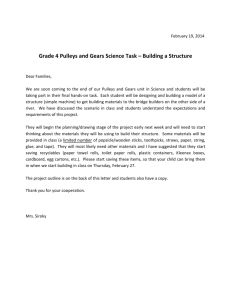

![Machine Elements [Opens in New Window]](http://s3.studylib.net/store/data/009054465_1-76bd66345967cd60934cd86eccae6fad-300x300.png)
